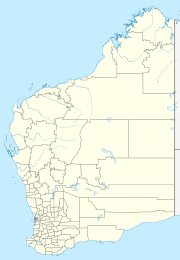Ngalingkadji Community facts for kids
Quick facts for kids NgalingkadjiWestern Australia |
|
|---|---|
| Postcode(s) | 6765 |
| Location | 60 km (37 mi) south east of Fitzroy Crossing, Western Australia |
| LGA(s) | Shire of Derby–West Kimberley |
| State electorate(s) | Kimberley |
| Federal Division(s) | Durack |
Ngalingkadji is a small Aboriginal community in Western Australia. It is located within the Shire of Derby–West Kimberley. The community is about 54 kilometers (33 miles) south-east of Fitzroy Crossing. You can reach it by the main Great Northern Highway and then a smaller road. Some people also call Ngalingkadji "Chestnut Bore."
Contents
A Look Back: Ngalingkadji's History
Most people in Ngalingkadji belong to the Gooniyandi language group. This group comes from the Fitzroy Valley area of Western Australia. Ngalingkadji became a lasting Aboriginal community in the early 1980s. Gooniyandi people who used to live at Gogo Station moved here. Many men from Gogo Station worked as stockmen, caring for cattle. The community officially became an incorporated group in 1983.
Understanding Native Title in Ngalingkadji
The land where Ngalingkadji is located is part of a special area. This area is called the Kurungal (WAD6217/98) native title claim. Native title means that Aboriginal people have rights to their traditional lands and waters. These rights come from their traditional laws and customs.
How Ngalingkadji is Managed
The Ngalingkadji community is run by its own group, called Ngalingkadji (Aboriginal Corporation). This group was officially set up on June 24, 1987. It operates under a law called the Aboriginal Councils and Associations Act 1976. This law helps Aboriginal groups manage their own affairs.
Planning for Ngalingkadji's Future
Ngalingkadji has a special plan for its growth and development. This plan is called Ngalingkadji Layout Plan No.1. It follows rules set by State Planning Policy 3.2 Aboriginal Settlements. The community approved this plan on August 27, 2010. The Western Australian Planning Commission also approved it on December 14, 2010. This plan helps guide how the community's land and buildings will be used.


